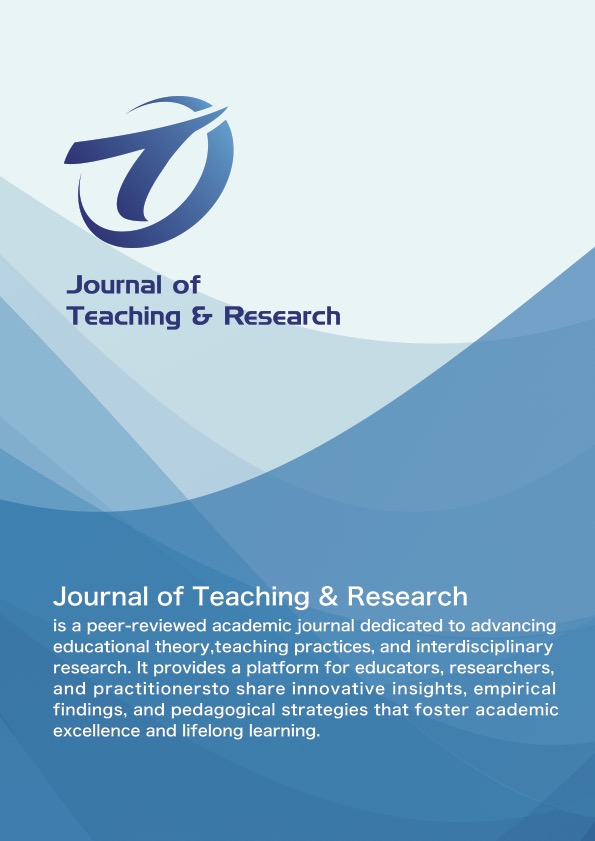A Case Study on the Effects of Blended Learning on College Students' Learning Motivation and Learning Outcomes
Using the Zhihuishu Online Learning Platform as a Case
DOI:
https://doi.org/10.65170/jtr.v1i1.7Keywords:
Blended learning; Learning motivation; Learning outcomes; Structural equation modeling; Zhihuishu platformAbstract
With the development of online education platforms, college students have widely engaged in blended teaching that combines online tools with face‑to‑face classes. Although research on online courses has surged, case studies focused on how college students actually use online platforms remain limited. Using Zhihuishu as a case, this study collected 289 questionnaires (270 valid users of the platform) and applied descriptive statistics, structural equation modeling (SEM), and chain mediation analysis to examine blended‑learning motivation for using the platform, patterns of use and perceived experience, and how these relate to learning outcomes, including the differential roles of intrinsic and extrinsic motivation. Findings indicate a clear differentiation in learning motivations: career development needs are the strongest driver, while the extrinsic motive of “studying under pressure” exhibits marked polarization. Regarding outcomes, knowledge transfer is rated highest, whereas perceived improvements in comprehensive competencies are lowest and strongly polarized. SEM shows that better user experience significantly boosts learning outcomes; by contrast, the direct effect of platform usage on outcomes is insignificant, suggesting that merely adding features does not translate into gains. The chain mediation test further shows that extrinsic motivation increases platform use but does not form an effective transmission chain; intrinsic motivation, however, improves outcomes directly. Based on the statistics, we recommend: strengthening career‑oriented drivers by adding case‑based resources; designing more engaging interactions to motivate passive learners; and prioritizing user‑experience optimization to convert motivation into achievement.
References
1. Wang, R., et al. (2023). Effects of a Zhihuishu‑based blended model in Medicinal Plant Cultivation. China Agricultural Education, 24(3), 78–85.
2. Chen, M., et al. (2023). Rain Classroom combined with flipped/divided classroom in college English translation: An empirical study. Foreign Language E‑Learning, (4), 63–69.
3. Wang, Z., et al. (2024). UMU‑supported blended teaching in vocational CNC training. China Vocational and Technical Education, 11, 45–52.
4. Liu, Y. (2023). Bottlenecks and pathways of Zhihuishu in university blended teaching. Modern Educational Technology, 33(5), 112–118.
5. Peng, R., & Fu, R. (2021). The effect of Chinese EFL students’ learning motivation on outcomes in blended environments. Australasian Journal of Educational Technology, 37(6). DOI: https://doi.org/10.14742/ajet.6235
6. Garrison, D. R., & Kanuka, H. (2004). Blended learning: Uncovering its transformative potential in higher education. The Internet and Higher Education, 7(2), 95–105. DOI: https://doi.org/10.1016/j.iheduc.2004.02.001
7. Graham, C. R. (2012). Blended learning systems. In C. J. Bonk & C. R. Graham (Eds.), Handbook of Blended Learning (pp. 3–21).
8. Ryan, R. M., & Deci, E. L. (2020). Self‑Determination Theory. Guilford Press.
9. Radulović, B., Dorocki, M., Olič Ninković, S., et al. (2023). Effects of a blended approach on students’ motivation for learning physics. Journal of Baltic Science Education, 22(1), 73–82. DOI: https://doi.org/10.33225/jbse/23.22.73
10. Shoukat, R., Ismayil, I., Huang, Q., et al. (2024). A comparative analysis of blended learning and traditional instruction: Effects on academic motivation and outcomes. PLoS ONE, 19(3), e0298220. DOI: https://doi.org/10.1371/journal.pone.0298220
11. Nortvig, A.‑M., et al. (2018). Factors influencing e‑learning and blended learning with respect to outcomes, satisfaction, and engagement. Electronic Journal of e‑Learning, 16(1).
12. Tayebinik, M., & Puteh, M. (2013). The effect of blended learning on students’ academic achievement and motivation.
13. Lim, D. H., & Morris, M. L. (2009). Learner and instructional factors influencing outcomes in blended environments. Educational Technology & Society, 12(4), 282–293.
14. Ghazizadeh, M., & Fatemipour, M. (2017). The impact of blended learning on improving students’ language skills.
15. Shih, P. C. (2010). The effectiveness of blended learning in an EFL context: A case study. Journal of Applied Linguistics, 5(2), 15–29.
16. Nortvig, J. M., Lykke, A., & Lindqvist, K. (2018). Blended learning in higher education: Instructional quality and student satisfaction. Higher Education Research & Development, 37(3), 524–537.
17. Jenatabadi, H. S. (2015). An overview of path analysis: Mediation in SEM. University of Malaya.
18. Xu, J., Wang, Y., Cheung, J. C., et al. (2024). Chain mediation between intergenerational support and mental health of older adults: A SEM approach. BMC Geriatrics, 24(1), 323. DOI: https://doi.org/10.1186/s12877-024-04883-9
19. Zhang, H., & Tian, M. (2007). Application of reliability analysis in questionnaire design. Statistics & Decision, (21), 25–27.
20. Wu, B. (2006). A preliminary study on structural equation modeling. Tianjin University. SPSSPRO (2021). Scientific Platform Serving for Statistics Professional (v1.0.11). Retrieved from https://www.spsspro.com
Downloads
Published
How to Cite
Issue
Section
License
Copyright (c) 2025 Xinyu Zhao

This work is licensed under a Creative Commons Attribution 4.0 International License.








